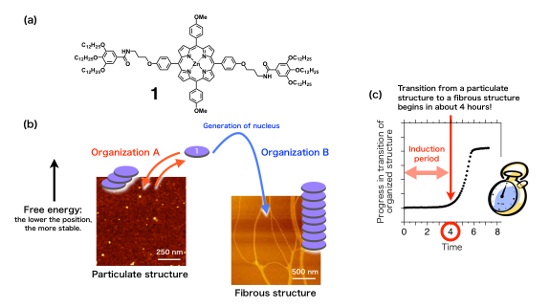World’s First Time-controlled Molecular Self-Organization

(a) Previously reported porphyrin molecule 1; (b) two kinds of self-organization in which porphyrin molecule 1 is able to take part. A particulate structure is formed early, but that disappears with time and then a fibrous structure is formed; (c) self-organization involving molecule 1 to form a fibrous structure begins in about four hours. Copyright : National Institute for Materials Science (NIMS)
At Japan's National Institute for Materials Science (Sukekatsu Ushioda, president), Senior Researcher Kazunori Sugiyasu and co-workers (Polymer Materials Unit [Izumi Ichinose, unit director], Advanced Key Technologies Division) developed a method for preprogramming the timing of molecules to initiate self-organization by mixing molecules with modified side chains.
The results of this research will be published in the German Chemical Society’s journal “Angewandte Chemie International Edition” in the near future. (S. Ogi, T. Fukui, M. L. Jue, M. Takeuchi, K. Sugiyasu, Article title: “Kinetic control over pathway complexity in supramolecular polymerization through modulating the energy landscape by rational molecular design” Angew. Chem. Int. Ed., DOI: 10.1002/anie.201407302)
Molecular self-organization is widely observed in nature, and is a critical phenomenon in terms of developing systems that perform complex functions as seen in such natural mechanisms as photosynthesis and neurocircuits. Attempts have been made to develop new materials capable of executing advanced functions using the principle behind the phenomenon of molecular self-organization.
However, due to the spontaneous nature of molecular self-organization, it is extremely difficult to control the phenomenon by design. In particular, almost no research had been conducted to control the timing of the self-organization phenomenon including control of when to initiate it.
Recently, we conducted research using a molecule that can form two types of self-organized structures. One type of the self-organized structures was quickly formed but was energetically unstable; therefore, after a certain period of time elapsed, the other type of the self-organized structures, which was energetically more stable, was eventually formed.
By modifying the side chains of the molecule, thereby inverting the energy stability levels between the two types of self-organized structures, we were able to synthesize a new type of molecule that only forms the former self-organized structure. By changing the mixing ratios between the original and new molecules, we succeeded for the first time in the world in controlling the timing at which an energetically stable self-organized structure begins to form.
Controlling such timing is similar to the mechanism behind the biological clock in organisms from the viewpoint that in both cases, such time-controlling process is carried out by a network of molecules consisting of several chemical species.
Self-organization is a vital concept in diverse fields such as materials science, nanotechnology and biotechnology, and is attracting much attention as a new method of synthesizing materials. By applying the method we developed in this research, we intend to develop advanced systems that are capable of emitting light or changing electrical conductivity at desirable timings. In the future, we hope to develop smart materials that autonomously function corresponding to the passing of time, like biomolecular systems do.
This research was funded by the Japan Society for the Promotion of Science’s grant-in-aid for scientific research on innovative areas, “dynamical ordering of biomolecular systems for creation of integrated functions” (Koichi Kato, Project Leader, National Institutes of Natural Sciences), and “π-system figuration” (Takanori Fukushima, Project Leader, Tokyo Institute of Technology).
Associated links
NIMS article
Media Contact
More Information:
http://www.researchsea.comAll latest news from the category: Materials Sciences
Materials management deals with the research, development, manufacturing and processing of raw and industrial materials. Key aspects here are biological and medical issues, which play an increasingly important role in this field.
innovations-report offers in-depth articles related to the development and application of materials and the structure and properties of new materials.
Newest articles

First-of-its-kind study uses remote sensing to monitor plastic debris in rivers and lakes
Remote sensing creates a cost-effective solution to monitoring plastic pollution. A first-of-its-kind study from researchers at the University of Minnesota Twin Cities shows how remote sensing can help monitor and…

Laser-based artificial neuron mimics nerve cell functions at lightning speed
With a processing speed a billion times faster than nature, chip-based laser neuron could help advance AI tasks such as pattern recognition and sequence prediction. Researchers have developed a laser-based…

Optimising the processing of plastic waste
Just one look in the yellow bin reveals a colourful jumble of different types of plastic. However, the purer and more uniform plastic waste is, the easier it is to…



